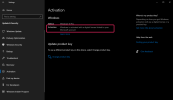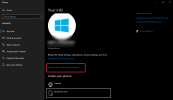LordX
Active Member
- Reaction score
- 58
Hey guys,
I have two systems that a customer built - extremely similar systems, each activated with a Digital License of Windows 10 Home (NOT tied to any MS account).
One system (his most critical) had the motherboard die, and he asked me to simply swap the hard drive from that one to the other. No problem. Boots fine and all his files/programs are now accessible.
Problem is, since the swap, Windows is now showing as NOT activated. Even though this motherboard is clearly digitally licensed. If I put the old drive back in, Activated...
A reformat is not an option at this point - so how can I have the Win10 installation detect the digital license of this motherboard?
Reinstalling windows 10 on a motherboard with a digital license never has given me issues, but this straight swap is.
I googled about resetting windows activation - and the only article was from windows 7 - the command: slmgr /upk which is for 'uninstall product key'.
Will this work for Digital Activation too?
Anyone ever run into this scenario?
I have two systems that a customer built - extremely similar systems, each activated with a Digital License of Windows 10 Home (NOT tied to any MS account).
One system (his most critical) had the motherboard die, and he asked me to simply swap the hard drive from that one to the other. No problem. Boots fine and all his files/programs are now accessible.
Problem is, since the swap, Windows is now showing as NOT activated. Even though this motherboard is clearly digitally licensed. If I put the old drive back in, Activated...
A reformat is not an option at this point - so how can I have the Win10 installation detect the digital license of this motherboard?
Reinstalling windows 10 on a motherboard with a digital license never has given me issues, but this straight swap is.
I googled about resetting windows activation - and the only article was from windows 7 - the command: slmgr /upk which is for 'uninstall product key'.
Will this work for Digital Activation too?
Anyone ever run into this scenario?


